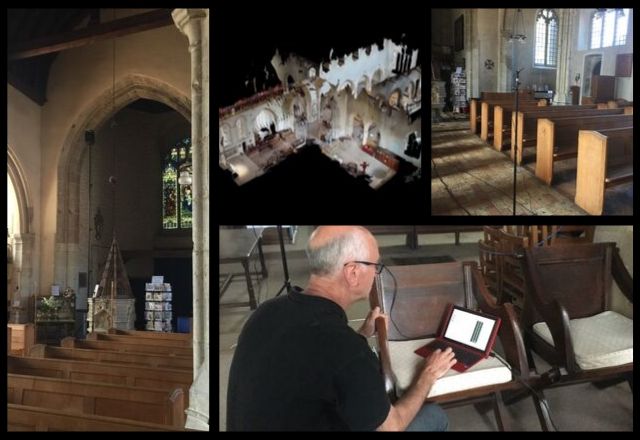We are living in an age where technology seems to be moving at a remarkable pace. I wonder if our Victorian forbears felt the same? I doubt it. Never before has technology so much entered our daily lives. Smart phones, video links and apps that allow us to turn off the home lights from far away. The advantages are numerous and readily accessible at relatively modest cost.
Viscount embraces new technology
Viscount embraces the opportunities that technology has brought to the musical world by uniquely using ultra high speed computers and software to create classic organ sounds. Based on many opinions expressed in social media the Viscount sound quality and flexibility delivered by this ‘Physis’ technology is second to none.
This led me to wonder how we could use state-of-the-art equipment to improve the delivery of our church organ installations. You can view approaching a thousand church and concert hall installations undertaken in the last 12 years on our customer installation map, which attest to our many years of experience.
By asking Viscount to make a proposal you will not only be drawing on that substantial expertise, but you can optionally benefit from new objective data that will further guide the advice we can offer. We recently demonstrated the benefits of this approach during a survey done at Holy Trinity, Rayleigh, and the acoustic measurement examples here are taken from that survey.
Firstly we can take a comprehensive 3D spatial picture of the building. This provides us with two valuable additional sets of data. It not only generates a fully dimensioned floor plan from which we can accurately calculate cabling requirements, but also we will have a 3D model from which our team can prepare a detailed work plan so that the installation job and challenges are familiar to them before arrival on site. This can be annotated with information about locations of loudspeakers, console and cables, for example, for presentation to advisory committees.
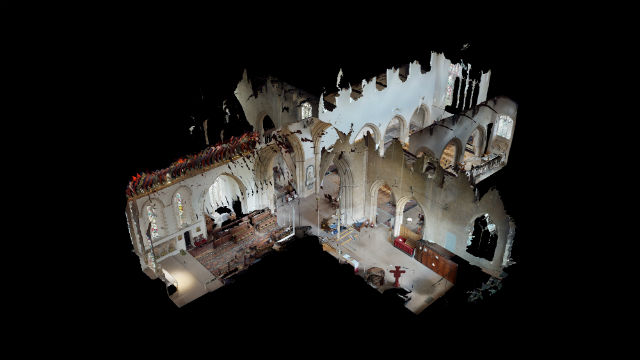
Objective data helping in loudspeaker installations
If the most important stop on an organ is the building’s acoustics, then it pays to get the best insights possible into how an organ loudspeaker installation will work in partnership with a particular space. Although many of the aspects of an installation and voicing are subjective and based on experience, it can also help to have objective data on which to base decisions.
Objective data relating to a building’s acoustics can be particularly useful when different people may need to work on the same project. For example, a project manager working back at base can get a better idea of the acoustics of the space in question even if they were not the one who did the survey.
Measurements can also help to create an objective record of a survey, and such data may be useful to church and diocesan committees, for example, to justify and explain installation and equipment recommendations.
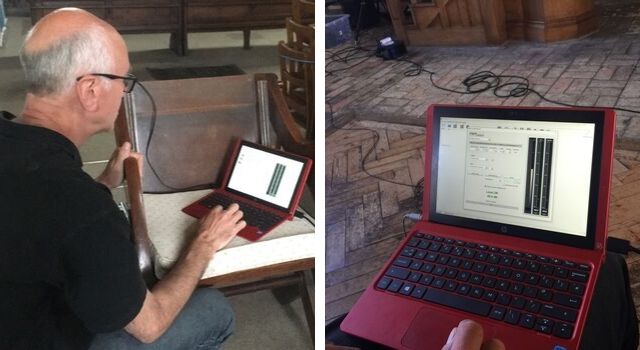
Direct sound from organ blending with building reverberation
The sorts of measurements we’re talking about here relate to the way in which the direct sound from the organ blends with the building’s reverberation at different points in the space. Also how loud the organ is likely to sound in different places in the building, and how its frequency response may be affected by room resonances, particularly at low frequencies.
In buildings with a long reverberation time, you don’t have to get far from the loudspeakers before the reverberant field of the space dominates the sound that is perceived. In the reverberant field the sound level is relatively consistent, and doesn’t change much as you move around.
When a building is rather “dry” or “dead”, however, the direct field can predominate and there can be much larger changes in sound level as you move away from the loudspeakers. In such buildings the location of the loudspeakers can be more critical, in order that those sitting near to them don’t perceive too high a level, while those far away think the organ sounds too quiet.
This aspect also affects the degree of articulation and detail that will be experienced in the organ sound, whether the organ sound will be well blended or not. In order to make such measurements we can raise a test loudspeaker to locations where we might put organ loudspeakers.
A recent survey from Holy Trinity in Rayleigh
During the recent survey at Holy Trinity, Rayleigh, we made measurements using a test loudspeaker with similar directional characteristics to the ones we often use for installations. It was mounted on a stand high enough to enable it to be raised to potentially suitable locations in the space, coupled with a subwoofer mounted on the floor to handle the lowest part of the frequency range.
The microphone and loudspeaker positions used are shown on the plan below. We investigated the acoustic response in the chancel, and at the front, middle and rear of the nave, with loudspeakers close to either side of the existing organ chamber, speaking into the nave and into the chancel, as well as high at the west end of the church.

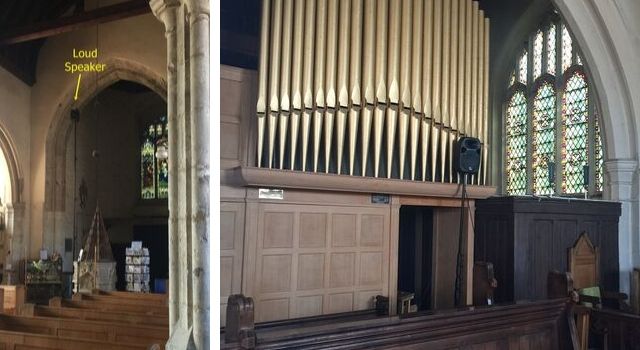
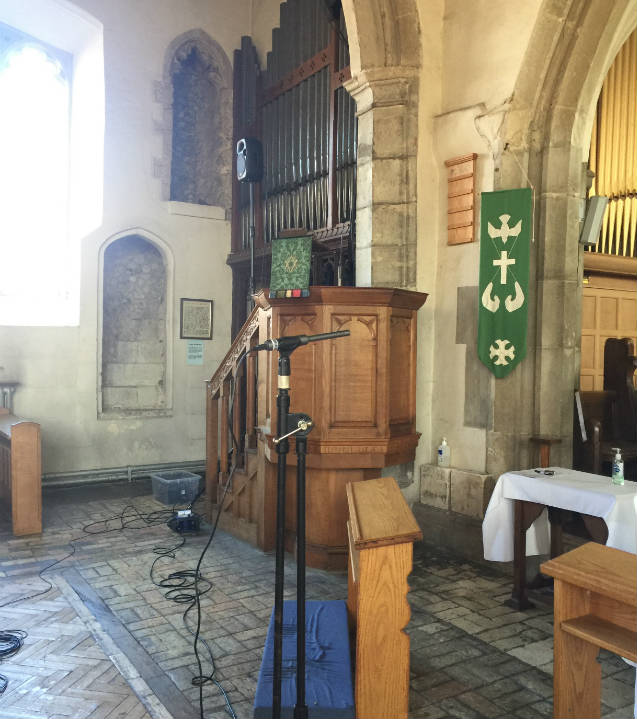
Using a fast fourier transform of a swept sine tone, measured using a calibrated omnidirectional microphone, our measurement software can extract a number of useful parameters such as reverberation time and early decay time in different bands, clarity (again in different bands, relating to the ratio between early and late reflected sound), and sound pressure level.
Waterfall plots enable the evolution of the spectrum to be seen over a time period, to identify where there are problematic resonances. We can do these measurements with loudspeakers in different orientations for example, to see how their directivity will affect the sound, particularly at high frequencies.
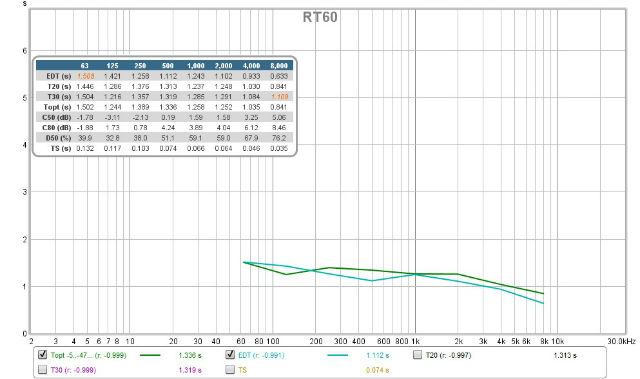
The acoustic clarity values (C80) derived from these measurements confirmed subjective impressions about likely perception of articulation and diffuseness in different parts of the church, for various potential loudspeaker locations. Other tests enabled us to evaluate the worst case differences in organ sound level between different locations in the church, for various speaker locations—important here as it was a relatively “dry” building.
Sound levels from a speaker set up in the choir fell off by some 12 dBA at the west end, roughly equivalent to a halving in perceived loudness (depending on the signal content). This suggested that a west end division, or duplication of part of the instrument to speak at the west end, could help to support congregational singing when the church is full and the rather modest reverberation therefore further reduced.
How can these measurements help us?
Measurements such as these can help to enable recommendations to be made about acoustic treatment in the building concerned, if that is an option during a refurbishment, to improve organ sound. They can also help to determine the need for multi-directional loudspeakers and their location, as well as whether more height is needed for loudspeaker installation. They can also help to determine the need for additional loudspeakers in distant parts of the building, if sound level differences are too great.

Viscount is at the forefront of developments in musical instrument technology, and will continue to innovate in ways that improve the experience for player and listener alike. By introducing advanced survey techniques to support its many years of experience with organs in public buildings, the company offers an unparalleled service to its customers.
I have had a passion for church organs since the tender age of 12. I own and run Viscount Organs with a close attention to the detail that musicians appreciate; and a clear understanding of the benefits of digital technology and keeping to the traditional and emotional elements of organ playing.
